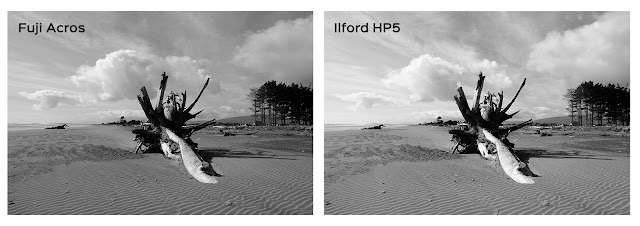My Fujifilm X-E2 film recipes for Landscapes
Now that I have gone through my seven custom film simulation recipes on my Fujifilm X-E2 (see previous blog posts), the final stage of the process is to do a comparison. This will help me decide which custom recipe I want to use, depending on the subject and feeling I'm after in my photo.
I think I have a pretty good idea anyway, but seeing them all together will help me confirm my suspicions. The first time I did this, I discovered that all my recipes were far too similar, and I decided to start over again from scratch. Hopefully this time will be different?
 |
| Black and White film simulation comparison for landscapes. Fuji Acros v Ilford HP5 |
Since I mostly shoot landscapes, I thought I'd start there with my comparisons. The image itself isn't anything spectacular, and it's taken at the wrong time of the day - noon on a bright day. But this is also a fairly good test since the dynamic range is at the extremes of what the sensor can handle. The compressed images for the web may not show it, but the tonal range in these images is practically perfect, without any clipping. Lightroom (where I process all my images) is showing that there is still highlight and shadow detail in all the images shown in this post - and all the comparison images are SOOC (straight out of camera).
The Acros and HP5 comparison for landscapes is about what I would expect. The Ilford simulation has a little more contrast than the Acros recipe, and I actually like both of them for landscapes. Either can be post-processed to look almost identical, although the Acros certainly has more tonal range to begin with due to it's slightly flatter tone curve. I will probably stick with Acros for 90% of my Black and White work, and leave HP5 for when I'm purposefully wanting a higher contrast look (see my last post here).
 |
| Carter's Beach B&W, Westport. Fuji X-E2. Acros film recipe processed in Lightroom |
While I do enjoy shooting landscapes in black and white, most of my photography is colour. So choosing my one or two top colour recipes for landscapes was going to be important.
Again, I had a fairly good idea of my top two, based on my previous experience trying each recipe. But it was also interesting to see the same image captured by all the film simulations for an ultimate comparison.
I've written several times during this process that Ektachrome E100SW takes pride-of-place in my C1 setting. After testing all the colour recipes together for landscape images, I haven't changed my mind. I love its saturated, contrasty, yet natural colours. It is by far my favourite landscape film recipe.
Next is actually a bit of a surprise, although I also said as much when I reviewed it here. If I love the E100SW simulation for its punchy, saturated colours, then my next choice should be Velvia - right? And while Velvia is nice, I definitely prefer E100SW. So no, Velvia is too similar to be my next choice.
My next choice would actually by Agfa Optima 200, for its slightly muted, more natural colours. In truth, the Agfa Optima image is the closest to what I actually saw with my own eyes when I was taking these images. The images it produces are just so darn pleasing to me. I don't know how else to describe it?
My third choice for landscapes would be a toss-up between the two remaining Kodak recipes - Portra and Gold. I'd probably lean more towards Gold to be honest, especially if I was after a 'warmer' landscape look. Gold is a little more contrasty - which is something I obviously like in my images.
 |
| Carter's Beach Colour, Westport. Fuji X-E2. Kodak Ektachrome E100SW film recipe |
So I guess, in the end - and rather somewhat predictably - E100SW wins the landscape round, with Agfa Optima second and Kodak Gold third. And for B&W, Acros is hard to beat for all types of photography.
I'm thinking, however, that it may be a different story in round two - portraiture?



Comments
Post a Comment